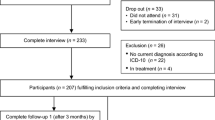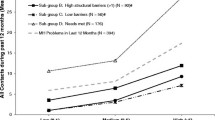Abstract
Background
Lack of mental health specialists in rural and remote communities suggest that rural communities depend more on general practitioners (GPs) for mental health care. Residents of rural communities are less likely than urban residents to seek help from their GPs for mental health issues. The aim of the current study was to examine whether attitudinal factors including perceived stigma, influenced rural residents seeking help from GPs.
Method
Help-seeking for psychological issues was retrospectively reported by 300 community residents in rural north-west Victoria. Current distress levels, functional disability, and current or lifetime syndromal disorder were recorded. Attitudes towards seeking professional psychological help, perceptions of stigma about mental illness, and belief in helpfulness of GPs, were also measured.
Results
Having a positive attitude towards seeking professional help, and believing that a GP would be helpful, were significant predictors of ever having sought help from a GP for mental health problems. Other independent predictors of help-seeking included having a mood, anxiety or substance use disorder, higher distress levels, and greater functional disability due to physical problems.
Conclusions
Seeking help from a GP for psychological problems was predicted by having a positive attitude towards seeking professional psychological help as well as believing a GP would be helpful in treating psychological problems. Illness variables were also strong predictors of help-seeking behaviour. Contrary to expectations, perceived stigma did not influence help-seeking. The findings of this study highlight the important role of GPs in the treatment of mental health problems in the rural community.
Similar content being viewed by others
References
Barry MM, Doherty A, Hope A, Sixsmith J, Kelleher CC (2000) A community needs assessment for rural mental health promotion. Health Educ Res 15:293–304
Bayer JK, Peay MY (1997) Predicting intentions to seek help from professional mental health services. Aust N Z J Psychiatry 31:504–513
Bucholz KK, Robins LN (1987) Who talks to a doctor about existing depressive illness? J Affect Disord 12:241–250
Smith LD, McGovern RJ, Peck PL (2004) Factors contributing to the utilization of mental health services in a rural setting. Psychol Rep 95:435–442
Wrigley S, Jackson H, Judd F, Komiti A (2005) The role of stigma and attitudes towards help-seeking from a GP for mental health problems in a rural town. Aust N Z J Psychiatry 39:514–521
Fuller J, Edwards J, Procter N, Moss J (2000) How definition of mental health problems can influence help seeking in rural and remote communities. Aust J Rural Health 8:148–153
Rost K, Smith R, Taylor JL (1993) Rural–urban differences in stigma and the use of care for depressive disorders. J Rural Health 9:57–62
Elliot-Schmidt R, Strong J (1997) The concept of well-being in a rural setting: Understanding health and illness. Aust J Rural Health 5:59–63
Barney LJ, Griffiths KM, Jorm AF, Christensen H (2006) Stigma about depression and its impact on help-seeking intentions. Aust N Z J Psychiatry 2006:51–54
Otey E, Fenton WS (2004) Editor’s introduction: building mental illness stigma research. Schizophr Bull 30:473–475
Blumenthal R, Endicott J (1996) Barriers to seeking treatment for major depression. Depress Anxiety 4:273–278
Jorm AF, Medway J, Christensen H, Korten AE, Jacomb PA, Rodgers B (2000) Attitudes towards people with depression: effects on the public’s help-seeking and outcome when experiencing common psychiatric symptoms. Aust N Z J Psychiatry 34:612–618
Fox JC, Blank M, Berman J, Rovnyak VG (1999) Mental disorders and help seeking in a rural impoverished population. Int J Psychiatry Med 29:181–195
Fuller J, Edwards J, Procter N, Moss J (2000) How definition of mental health problems can influence help seeking in rural and remote communities. Aust J Rural Health 8:148–153
Pescosolido B, Gardner CB, Lubell KM (1998) How people get into mental health services: stories of choice, coercion, and “muddling through” from “first-timers”. Soc Sci Med 46:275–286
Rost K, Smith R, Taylor JL (1993) Rural–urban differences in stigma and the use of care for depressive disorders. J Rural Health 9:57–62
Hoyt DR, Conger RD, Valde JG, Weihs K (1997) Psychological distress and help seeking in rural America. Am J Community Psychol 25:449–70
Jorm AF (2000) Mental health literacy. Public knowledge and beliefs about mental disorders. Br J Psychiatry 177:396–401
Paslow RA, Jorm AF (2000) Who uses mental health services in Australia? An analysis of data from the National Survey of Mental Health and Wellbeing. Aust N Z J Psychiatry 34:997–1008
Humphreys JS, Mathews-Cowey S, Weinand HC (1997) Factors in accessibility of general practice in rural Australia. Med J Aust 166:577–580
Murray G, Judd F, Jackson H, Fraser C, Komiti A, Hodgins G, Pattison P, Humphreys J, Robins G (2004) Rurality and mental health: the role of accessibility. Aust N Z J Psychiatry 38:629–634
First MB, Spitzer RL, Gibbon M, Williams JBW (1996) Structured clinical interview for DSM-IV Axis I Disorders, Clinician Version (SCID-CV). American Psychiatric Press, Washington, DC
Kessler RC, Andrews G, Colpe LJ, Hiripi E, Mroczek DK, Normand SL, Walters EE, Zaslavsky AM (2002) Short screening scales to monitor population prevalences and trends in non-specific psychological distress. Psychol Med 32:959–976
Andrews G, Henderson S, Hall W (2001) Prevalence, comorbidity, disability and service utilisation: overview of the Australian National Mental Health Survey. Br J Psychiatry 178:145–153
Ware JE, Kosinski M, Keller SD (1996) A 12-item short form health survey. Med Care 34:220–233
Korten AE, Henderson S (2000) The Australian National Survey of Mental Health and Well-Being: common psychological symptoms and disablement. Br J Psychiatry 177:325–330
Link BG (1987) Understanding the labeling effects in the area of mental disorders: an assessment of the effects of expectations of rejection. Am Sociol Rev 52:96–112
Link BG, Mirotznik J, Cullen FT (1991) The effectiveness of stigma coping orientations: can negative consequences of mental illness labeling be avoided? J Health Soc Behav 32:302–320
Fischer EH, Turner JL (1970) Orientations to seeking professional help: development and research utility on an attitude scale. J Consult Clin Psychol 35:79–90
SPSS (2004) Statistical package for the social sciences
Weinert C, Long K (1987) Understanding the health care needs of rural families. Fam Relat 36:450–455
Lin E, Goering P, Offord DR, Campbell D, Boyle MH (1996) The use of mental health services in Ontario: epidemiologic findings. Can J Psychiatry 41:572–577
Shapiro DA, Skinner E, Kessler RC, Korff M, German P, Tischler GL, Leaf PJ, Benham L, Cottler L, Regier D (1984) Utilization of health and mental health services: three Epidemiologic Catchment Area sites. Arch Gen Psychiatry 41:971–978
Kessler RC, Brown RL, Broman CL (1981) Sex differences in psychiatric help-seeking: evidence from four large-scale surveys. J Health Soc Behav 22:49–64
Mojtabai R, Olfson M, Mechanic D (2002) Perceived need and help-seeking in adults with mood, anxiety, or substance use disorders. Arch Gen Psychiatry 59:77–84
beyondblue: the national depression initiative http://www.beyondblue.org.au. Accessed 30 September 2005
Author information
Authors and Affiliations
Corresponding author
Rights and permissions
About this article
Cite this article
Komiti, A., Judd, F. & Jackson, H. The influence of stigma and attitudes on seeking help from a GP for mental health problems. Soc Psychiat Epidemiol 41, 738–745 (2006). https://doi.org/10.1007/s00127-006-0089-4
Accepted:
Published:
Issue Date:
DOI: https://doi.org/10.1007/s00127-006-0089-4




